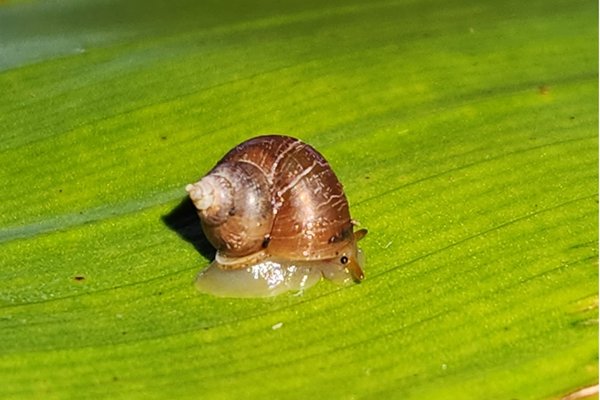A rare land snail from north Queensland
The Mossman Gorge Treesnail is part of a group of snails (Meliobba) that occurs in both Australia and New Guinea. Connections between Cape York and New Guinea have been shown to occur in birds and mammals, and a so a land snail connection should not be unexpected. However, this supposed kinship is based solely on the similarity in shell shape between the Australian and New Guinea species. Not unsurprisingly, the accuracy of this connection has been called into serious question. The recent find of two live specimens from north Queensland opens the way for more rigorous anatomical and molecular studies that will hopefully shed new light on the true relationhips of this impressive looking terrestrial gastropod.

© Tim Hawkes
In 1940 the Curator of Molluscs at the Australian Museum, Tom Iredale (1880-1972) described the Mossman Gorge Treesnail Meliobba shafferyi after the late Joe Shaffery who collected this land snail from the Mossman area of northern Queensland. At the time Iredale, who was also a respected ornithologist, was attempting to show relationships between the New Guinean and northern Australian land snails in much the same way that he had done for some birds. To his astonishment a consignment of land snails from Mr Shaffery, who was a Mossman local with an interest in natural history, included specimens of this impressive species.
The shell of the Mossman Gorge Treesnail measures approximately 45 mm in diameter and 25 mm in height, and is notable for its vivid colouration which contrasts with the many shades of brown that are a fairly constant feature of shells of Australian land snails. Another uncommon characteristic of the shell was the surface sculpture which consisted of concentric indentations. This unusual combination of characters immediately led Iredale to making comparisons with some similar looking New Guinean species which he later placed in the genus Negotobba. This genus was later synonymised with Meliobba by American malacologists William Clench and Ruth Turner who added a number of other species from the New Guinean region, thereby cementing the connection with northern Australia.
In 1998, former Museum of Tropical Queensland scientist Bronwen Scott gained access to a single live specimen of the species. Scott’s studies on the species’ reproductive anatomy and subsequent comparisons with similar structure in New Guinean Meliobba, indicated that the previous associations based on similarity of shell characters alone were questionable. The accompanying image of the adult specimen is the first known photograph of this spectacular species.
To this day the Mossman Gorge Tree Snail is considered a rare snail and only a few shells exist in museum collections. The Australian Museum is custodian of the holotype (AMSC.62205) and a single paratype. My past efforts to locate live specimens in Mossman Gorge have proven fruitless.The recent discovery of two live specimens (one adult, one subadult) by Tim Hawkes in the Whyanbeel Valley, near Mossman, will enable DNA studies to be carried out on the species in an effort to establish its true origins.
Land snails play an important part in the decomposition process breaking down rotting vegetation and converting it into protein which is available to animals further up the food chain such as birds, lizards and mammals. They also renutrify the soil with their dead remains and calcium rich shells. Moreover, a rare land snail such as the Mossman Gorge Treesnail, which presumably has a small environmental envelope, is a likely sentinel species for monitoring the impacts of climatic variations and other global environemtal change.
From these perspectives it makes practical sense to care about the continued conservation of the Mossman Gorge Treesnail into the future. The snail’s inherent beauty and its role in Australia’s largely endemic and unique biodiversity are no less reasons for caring!
Dr John Stanisic, AMRI Research Associate
More information:
- Clench, W.J. & Turner, R.D. (1962) Monographs of the genera Papustyla, Forcartia and Meliobba (Papuininae: Camaenidae). Journal of the Malacological Society of Australia 1, 3-33.
- Iredale, T. (1940) A New Guinea land shell in Queensland. The Australian Naturalist 10, 239-240.
- Scott, B. (1998) Anatomy and relationships of the papuinine land shell Meliobba shafferyiIredale, 1940 (Pulmonata: Stylommatophora: Camaenidae). Molluscan Research 19, 59-68.
- Stanisic, J., Shea, M., Potter, D. & Griffiths, O. (2010) Australian land snails Volume 1, A field guide to eastern Australian species. Bioculture Press: Mauritius.










